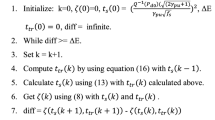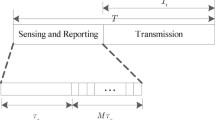Abstract
Due to the dramatic increase of energy consumption in wireless communication applications, energy-efficient networking solutions have drawn growing attentions. In this paper, we concentrate on the design of an energy-efficient sensing and transmission strategy for a secondary user (SU) in a cognitive radio network. We consider the scenario that multiple heterogeneous licensed channels exist, and the SU senses channels according to a sequence before it decides to access or to sleep. Energy is consumed in sensing, transmission and operating. We model the occupancy activities of primary users as a Markov process, and formulate the problem of dynamically sensing, transmission or sleep as a partially observable Markov decision process. To solve the problem, we discuss the myopic policy which merely focuses on the energy efficiency over a frame. By exploring a parametric problem, we establish the optimal threshold structure of the strategy, according to which the SU decides the sensing order, as well as when and which channel to access. Furthermore, we design both optimal and approximate algorithms accordingly. Simulation results show that our algorithms can effectively increase the energy efficiency compared with the full sensing, random sensing and throughput maximization algorithms, while keep limited loss of throughput.





Similar content being viewed by others
Notes
Note that the sensing and transmission strategy during a frame is still a POMDP problem, and our myopic strategy solving the problem over a frame instead of over a operation duration.
References
Li, H., Feng, X., Gan, X., & Cao, Z. (2013). Joint spectrum sensing and transmission strategy for energy-efficient cognitive radio networks. IEEE CROWNCOM, 2013, 99–104.
Smart2020: Enabling the low carbon economy in the information age. The Climate Group SMART 2020 Report, 2008. http://www.theclimategroup.org
Dejonghe, A., Bougard, B., Pollin, S., Craninckx, J., Bourdoux, A., der Perre, L. V., et al. (2007). Green reconfigurable radio systems. IEEE Signal Processing Magazine, 24(3), 90–101.
Zuckerman, D. (2009). Green communications–management included. http://www.green-communications.net/icc09/program.html
Mitola, J., & Maguire, G. Q. (1999). Cognitive radio: Making software radios more personal. IEEE Personal Communications, 6(4), 13–18.
Xu, Y., Anpalagan, A., Wu, Q., Shen, L., Gao, Z., & Wang, L. (2013). Decision-theoretic distributed channel selection for opportunistic spectrum access: Strategies, challenges and solutions. IEEE Communications Surveys & Tutorials, 15(4), 1689–1713.
Cui, S., Goldsmith, A. J., & Bahai, A. (2005). Energy-constrained modulation optimization. IEEE transactions on wireless communications, 4(5), 2349–2360.
Chen, Y., Zhao, Q., & Swami, A. (2009). Distributed spectrum sensing and access in cognitive radio networks with energy constraint. IEEE Transactions on Signal Process, 57(2), 783–797.
Hoang, A. T., Liang, Y.-C., Wong, D. T. C., Zeng, Y., & Zhang, R. (2009). Opportunistic spectrum access for energy-constrained cognitive radios. IEEE Transactions on Wireless Communications, 8(3), 1206–1211.
Wang, S., Wang, Y., Coon, J. P., & Doufexi, A. (2012). Energy-efficient spectrum sensing and access for cognitive radio networks. IEEE Transactions on Vehicular Technology, 61(2), 906–912.
Huang, S., Chen, H., Yan, Z., & Chen, H. (2013). Sensing-energy tradeoff in cognitive radio networks with relays. IEEE Systems Journal, 7(1), 68–76.
Pei, Y., Liang, Y.-C., Teh, K. C., & Li, K. H. (2011). Energy-efficient design of sequential channel sensing in cognitive radio networks: Optimal sensing strategy, power allocation, and sensing order. IEEE Journal on Selected Areas in Communications, 29(8), 1648–1659.
Jiang, H., Lai, L., Fan, R., & Poor, H. V. (2008). Cognitive radio: How to maximally utilize spectrum opportunities in sequential sensing. IEEE GLOBECOM, 2008, 1–5.
Smallwood, R., & Sondik, E. (1973). The optimal control of partially observvable markov process over a finite horizon. Operations Research 21(5), 1071–1088
Ahmad, S., Liu, M., Javidi, T., Zhao, Q., & Krishnamachari, B. (2009). Optimality of myopic sensing in multichannel opportunistic access. IEEE Transaction on Information Theory, 55(9), 4040–4050.
Chang, N. B., & Liu, M. (2009). Optimal channel probing and transmission scheduling for opportunistic spectrum access. IEEE/ACM Transaction on Networking, 17(6), 1805–1818.
Sudipto, G., Munagala, K., Sarkar, S. (2006). Jointly optimal transmission and probing strategies for multichannel wireless systems. IEEE 2006 40th annual conference on information sciences and systems, pp. 955–960.
Boyd, S., & Vandenberghe, L. (2009). Convex optimization. Cambridge: Cambridge University Press.
Acknowledgments
This work is supported by NSF China (No. 91438115, U1405251); NSF of Fujian Province (No. 2013J01235); Research Fund of Fuzhou University (No. 2013-XY-27, 2014-XQ-37, XRC-1460).
Author information
Authors and Affiliations
Corresponding author
Additional information
Parts of this work were presented at IEEE CROWNCOM 2013, 8–10 July, Washington DC, United States [1].
Rights and permissions
About this article
Cite this article
Feng, X., Gan, X. Energy-Efficient Design of Sensing and Transmission in Cognitive Radio Networks. Wireless Pers Commun 84, 1647–1662 (2015). https://doi.org/10.1007/s11277-015-2525-9
Published:
Issue Date:
DOI: https://doi.org/10.1007/s11277-015-2525-9




